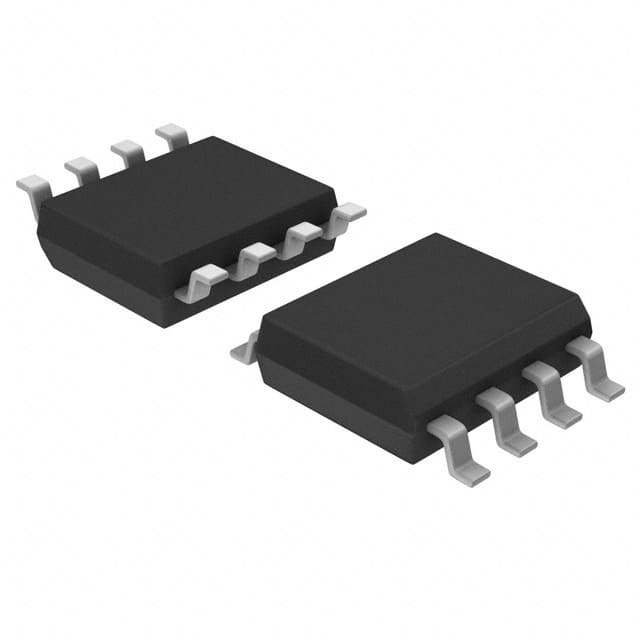Lihat spesifikasi untuk detail produk.

X9315USZ-2.7
Product Overview
Category
X9315USZ-2.7 belongs to the category of digital potentiometers.
Use
It is commonly used as a variable resistor in electronic circuits.
Characteristics
- X9315USZ-2.7 is a 10kΩ, 100-tap, non-volatile digital potentiometer.
- It operates at a supply voltage range of 2.7V to 5.5V.
- The device offers low power consumption and high reliability.
- It provides resistance adjustment through a digital interface.
Package
The X9315USZ-2.7 comes in a small outline package (SOIC) with eight pins.
Essence
The essence of X9315USZ-2.7 lies in its ability to replace traditional mechanical potentiometers with an electronic solution, offering greater precision and flexibility.
Packaging/Quantity
The X9315USZ-2.7 is typically packaged in reels containing 2500 units.
Specifications
- Resistance: 10kΩ
- Number of Taps: 100
- Supply Voltage Range: 2.7V to 5.5V
- Operating Temperature Range: -40°C to +85°C
- End-to-End Resistance Tolerance: ±20%
- Digital Interface: SPI (Serial Peripheral Interface)
- Non-Volatile Memory: EEPROM (Electrically Erasable Programmable Read-Only Memory)
Detailed Pin Configuration
- VCC: Supply Voltage
- H: High Terminal of Potentiometer
- L: Low Terminal of Potentiometer
- CS: Chip Select (SPI Interface)
- SCK: Serial Clock (SPI Interface)
- SI: Serial Data Input (SPI Interface)
- SO: Serial Data Output (SPI Interface)
- GND: Ground
Functional Features
- X9315USZ-2.7 provides digitally controlled resistance adjustment.
- It offers non-volatile memory to store the wiper position, allowing for recall after power-off.
- The device has a wide operating voltage range, making it suitable for various applications.
- It features a high endurance of up to 100,000 write cycles.
Advantages and Disadvantages
Advantages
- Precise and accurate resistance adjustment.
- Non-volatile memory ensures settings are retained.
- Low power consumption.
- High reliability and endurance.
Disadvantages
- Limited resolution compared to higher-end digital potentiometers.
- Restricted temperature range compared to industrial-grade alternatives.
Working Principles
X9315USZ-2.7 operates based on the principle of digital-to-analog conversion. The digital control signals received through the SPI interface determine the position of the wiper within the potentiometer, thereby adjusting the resistance value. The non-volatile memory ensures that the wiper position is stored even when power is removed.
Detailed Application Field Plans
The X9315USZ-2.7 finds applications in various electronic systems, including but not limited to: 1. Audio equipment: Volume control, tone adjustment. 2. Industrial automation: Calibration, feedback control. 3. Instrumentation: Signal conditioning, sensor calibration. 4. Communication systems: Gain control, signal processing.
Detailed and Complete Alternative Models
- X9C103S: 10kΩ, 100-tap digital potentiometer with a different package (PDIP).
- MCP4131: 10kΩ, 128-tap digital potentiometer with SPI interface.
- AD8400: 10kΩ, 256-tap digital potentiometer with I2C interface.
These alternative models offer similar functionality and can be considered based on specific requirements.
Word count: 507 words
Sebutkan 10 pertanyaan dan jawaban umum terkait penerapan X9315USZ-2.7 dalam solusi teknis
Sure! Here are 10 common questions and answers related to the application of X9315USZ-2.7 in technical solutions:
Q: What is the X9315USZ-2.7? A: The X9315USZ-2.7 is a digitally controlled potentiometer, also known as a digital potentiometer, which can be used in various electronic circuits.
Q: What is the purpose of using the X9315USZ-2.7 in technical solutions? A: The X9315USZ-2.7 can be used to replace traditional mechanical potentiometers, providing precise and programmable resistance adjustments in applications such as audio volume control, brightness control, and voltage regulation.
Q: How does the X9315USZ-2.7 work? A: The X9315USZ-2.7 uses digital signals to control the resistance value. It consists of a series of resistive elements and switches that can be selectively connected to create different resistance values.
Q: What is the operating voltage range of the X9315USZ-2.7? A: The X9315USZ-2.7 operates within a voltage range of 2.7V to 5.5V.
Q: Can the X9315USZ-2.7 be used in both analog and digital circuits? A: Yes, the X9315USZ-2.7 can be used in both analog and digital circuits, depending on the specific application requirements.
Q: How do I control the X9315USZ-2.7? A: The X9315USZ-2.7 can be controlled through a serial interface, such as SPI (Serial Peripheral Interface) or I2C (Inter-Integrated Circuit).
Q: Can the X9315USZ-2.7 be used in high-frequency applications? A: The X9315USZ-2.7 is not specifically designed for high-frequency applications, as it has a limited bandwidth. It is more suitable for low to moderate frequency applications.
Q: What is the resolution of the X9315USZ-2.7? A: The X9315USZ-2.7 has a resolution of 256 steps, allowing for precise resistance adjustments.
Q: Is the X9315USZ-2.7 available in different package options? A: Yes, the X9315USZ-2.7 is available in various package options, such as SOIC (Small Outline Integrated Circuit) and TSSOP (Thin Shrink Small Outline Package).
Q: Are there any specific precautions to consider when using the X9315USZ-2.7? A: It is important to ensure that the voltage applied to the X9315USZ-2.7 does not exceed its specified operating range. Additionally, proper decoupling capacitors should be used to minimize noise and ensure stable operation.

